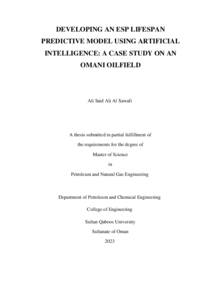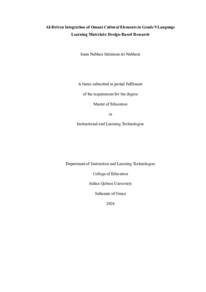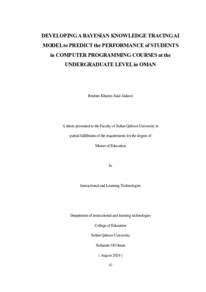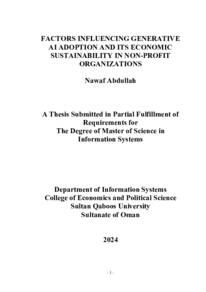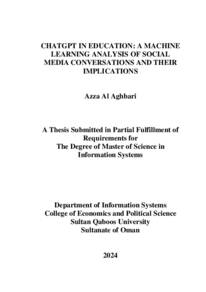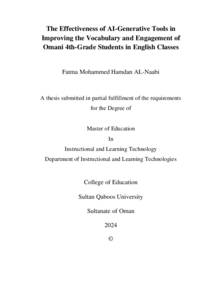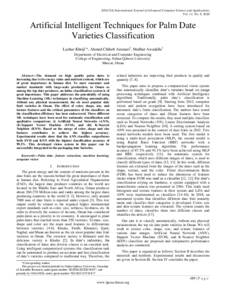Document
Developing an ESP lifespan predictive model using artificial intelligence : a case study on an Omani oil field.
Other titles
تطوير نموذج تنبؤي للعمر المتوقع للمضخة الغاطسة الكهربائية باستخدام الذكاء الاصطناعي : دراسة حالة حول حقل نفطي ُعماني
Publisher
Sultan Qaboos University.
Gregorian
2023
Language
English
English abstract
The Electrical Submersible Pump (ESP) is the most efficient and reliable artificial lift
method for medium to high production rates. While the capital cost of ESP is high, it
pales in comparison to the production losses resulting from its failure. Machine learning
(ML) is a branch of artificial intelligence, and it has gained substantial attention in oil
and gas industries recently by virtue of its predictive power. This study aims to develop
an ML model to predict ESP lifespan and identify the key features that influence its
longevity.
A general review is conducted for the ESP failure analysis approach and the previously
applied predictive maintenance to monitor, troubleshoot and predict its failure (PFA).
The study explores various ML algorithms and their applications in predicting the time
and type of ESP failures in different fields worldwide. The aims of this thesis were
directed through ESP static and historical data to be achieved based on the literature
review. The failure history of more than 100 wells from an Omani oilfield was
reviewed, with 132 ESP failures attributed to sand and scale accumulation. The dataset
includes 36 static features related to ESP design, installation, commissioning, failure,
pull-out and teardown. Data were split into training and testing sets by a ratio of 70:30.
Hundreds of tests were performed to five selected algorithms in order to optimize the
parameters and hyperparameters of each algorithm, based on mean absolute error,
average residual and determination coefficient. The algorithms tested were Decision
Tree Regressor (DTR), Least Absolute Shrinkage and Selection Operator (LASSO),
Random Forest Regressor (RFR), Support Vector Regressor (SVR), and Extreme
Gradient Boosting Regressor (XGBR). Outliers were retrained if their predicted values
exceeded a predetermined limit.
The final model was developed in two levels to estimate ESP lifespan after installation
and after the last valid well test. SVR and RFR were chosen for the first and second
models, respectively. The average model predictions yielded a mean absolute error of
25 days for the first level with a 60% determination coefficient and 8 days for the second
level with a 73% determination coefficient. The model`s analysis indicated that certain
factors related to the pump and motor design have the greatest impact on ensuring a
long-lasting ESP before it is commissioned, based on the model's first level. These
include features such as pump discharge pressure, number of pump stages, motor
frequency, and shaft RPM, underscoring the critical role of careful selection and design
of ESP components. On the other hand, during the operational lifespan of the ESP, the
most important features to monitor and control are pump discharge pressure and flow
rates of oil and water, as highlighted by the model's second level.
By scheduling ESP maintenance before failure, these findings can help mitigate capital
costs, while preparing the necessary hoist, rig, and materials for ESP replacement can
avoid deferred operational costs.
Member of
Resource URL
Arabic abstract
المضخة الغاطسة الكهربائية هي أكثر طرق الرفع الاصطناعي كفاءة وثباتا لمعدلات الانتاج المتوسطة والعالية، على الرغم من ارتفاع التكلفة الرأسمالية لهذه المضخة، الا أنها ال تقارن بالتكلفة العالية لخسائر الانتاج نتيجة فشلها وسقوطها، التعلم الالي هو فرع من فروع الذكاء الاصطناعي، وقد اكتسب صيتًا واسعًا في حقول النفط والغاز نتيجة قدراته التنبؤية، تهدف هذه الدراسة إلى تطوير نموذج للتعلم الالي لتنبؤ مدة حياة المضخة الغاطسة الكهربائية وتحديد أهم العوامل المؤثرة على حياتها. ابتدأت الدراسة بعمل مراجعة عامة لتحليل فشل هذه المضخات وتطبيقات صيانتها في مراقبة وتصحيح وتنبؤ سقوطها، ومراجعة العديد من خوارزميات التعلم الالي المستخدمة وتطبيقاتها في تنبؤ وقت ونوع الفشل لهذه المضخات في مختلف حقول النفط حول العالم، وقد تم توجيه أهداف البحث بناء على هذه المراجعات إلى البيانات المستقرة والتاريخية من المضخة الغاطسة الكهربائية، أكثر من 100 بئر نفط في حقل نفط عماني قد تمت مراجعته ُعدّت تحتوي حيث استُخرج منها 132 مضخة فشلت نتيجة تراكم الرمل ومخلفات الانتاج، قائمة البيانات التي أ على 36 عامل مستقر متعلق بتصميم المضخة وتثبيتها وتشغيلها وفشلها وسحبها وتفكيكها، قُسمت هذه البيانات إلى %70 للتدريب و%30 لالختبار، مئات الاختبارات قد أجريت على خمس خوارزميات منتقاة لتحسين معالم كل خوارزمية بالاعتماد على متوسط مجموع الفروق بين القيم الحقيقية والمتوقعة بالقيمة المطلقة ومعامل التحديد، هذه Decision Tree Regressor (DTR), Least Absolute Shrinkage and هي المستخدمة الخوارزميات Selection Operator (LASSO), Random Forest Regressor (RFR), Support Vector عادُي المتطرفة النتائج ، Extreme Gradient Boosting Regressor (XGBR)و Regressor (SVR), اعتمادا على الحد الاقصى المحدد سابقً تدريبها إذا تجاوزت قيمها المتوقعة ا. النموذج النهائي يحتوي على مستويين: مستوى لتوقع مدى الحياة الكامل قبل تشغيل المضخة والاخر لتوقع المتبقي من حياة المضخة بعد آخر اختبار لصالحية البئر، RFR اُختيرت للمستوى الاول وSVR قد اختيرت للمستوى الثاني، المستوى الاول استطاع توقع مدى حياة المضخة مع متوسط خطأ يصل إلى 25 يوما نتجت من نسبة %60 لمعامل التحديد، واستطاع المستوى الثاني توقع المتبقي من حياة المضخة مع متوسط خطأ يصل إلى 8 أيام نتجت من نسبة %73 لمعامل التحديد، وقد أشار المستوى الاول إلى أن بعض العوامل المتعلقة بتصميم وتصنيع المضخة والمحرك لها أكبر تأثير على ضمان عمر طويل قبل التشغيل، هذه العوامل تشتمل على ضغط تصريف المضخة وعدد مراحلها وتردد المحرك وسرعة دوران المحور، الامر الذي يؤكد الدور الحاسم لعملية اختيار وتصميم مكونات المضخة الغاطسة الكهربائية، من ناحية أخرى فإن المستوى الثاني أوضح أن أهم الميزات التي يجب مراقبتها والتحكم بها خالل فترة عمر المضخة هي ضغط تصريف المضخة ومعدلات تدفق النفط والماء. من المعتقد أن هذه النتائج يمكن أن تساعد على تخفيف التكاليف الرأسمالية من خلال جدولة صيانة المضخة قبل الفشل لإطالة حياتها، بينما يمكن تجنب التكاليف التشغيلية عن طريق التحضير لرفع المضخة وتحضير المعدات اللازمة لاستبدالها لتجنب خسائر الانتاج.
Category
Theses and Dissertations

